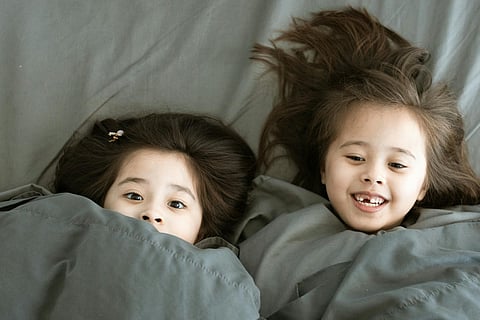Why your child’s pyjamas could be the secret to better sleep — especially in Dubai
The right fabric and fit can play an intrinsic role in how well a child sleeps

Goldilocks got it right, folks. She didn’t rest till she found the fit that suited her needs, even if it meant breaking into a bear family’s home and eating their porridge.
But take a page from her morally grey book when it comes to your children’s sleepwear.
So for parents, if you’ve ever wondered why your child wakes up sweaty, restless or their blanket kicked to the floor, the answer might go beyond routines or tantrums: It’s in what they wear to bed. As many mums would vouch, children’s sleepwear isn’t just about sweet prints and matching sets. The right fabric, fit, and even stretch can play an intrinsic role in how deeply and safely a child sleeps, especially in climates like Dubai’s where temperatures fluctuate between hot nights and cool, air-conditioned rooms.
So, what should parents be dressing their children in for better sleep?
Why pyjamas matter more than you think
It all boils down to the body temperature. The right sleepwear directly impacts how anyone sleeps, and children, perhaps especially so.
As Bethany Oakes, the Global Brand Manager at Snuz says, “As children aren’t as effective at regulating heat as adults, breathable and comfortable nightwear helps them settle more easily and stay asleep for longer.” For younger children, Oakes says many parents prefer sleeping bags, to create a snug and secure environment. “It keeps them cosy without loose blankets that can be kicked off, helping little ones stay comfortable throughout the night,” she adds.
It’s more than comfort — it’s about association. When children consistently wear soft, breathable sleepwear, they begin to link it with bedtime and calm, making nighttime transitions easier.
The hidden sleep disruptor: Heat
You may not realise it, but overheating is one of the biggest reasons children wake through the night. “If they become too warm, too cold, or restricted by their clothing, they’re more likely to stir or wake,” says Oakes.
Tight or synthetic sleepwear can trap heat and moisture, leading to skin irritation — and in babies, improper temperature regulation can even impact sleep safety. “Overheating is one of the biggest sleep disruptors for babies and young children, especially in warmer climates like Dubai,” Oakes points out.
The sleepwear rules
There’s a reason why even adults can’t wait to get back home, discard their formals and snuggle in pyjamas. It’s comfort. It’s calming. And, it’s healthy too.
Good sleep, starts with good clothes., Dr. Ruhil Badiani, Consultant Family Physician and Medical Director at Cornerstone Clinic, explains why it’s even more crucial for children. “What a child wears to bed directly affects how comfortably they sleep,” she explains. “If the material is too thick, rough, or synthetic, it can trap heat or irritate the skin, leading to frequent awakenings. Comfortable, breathable fabrics promote deeper, more restorative sleep by keeping the body at an optimal temperature.” Dr. Badiani warns that tight or non-breathable clothing can also lead to skin issues.
“It can increase the risk of rashes, fungal infections, and irritation,” she says. “For younger children, restrictive clothing can interfere with their natural movement during sleep. Breathable fabrics also help prevent overheating, a known risk factor for SIDS in babies.”
And when it comes to room temperature, slightly cool wins every time. As she says, children, like adults, tend to fall asleep faster and sleep more soundly, when their core temperature drops slightly. “A cooler sleep environment — around 20–22°C — supports the body’s natural sleep rhythm.”
Dubai’s weather, however, calls for a smart seasonal switch. “In summer, lightweight cotton or bamboo pyjamas are ideal,” she advises. “In winter, long-sleeved cotton sleepwear with a light blanket works well, but avoid heavy fabrics unless the room is genuinely cool.”
Her personal favourite: Bamboo. “It has excellent thermoregulating properties — keeping children cool in summer and warm in winter, while being gentle on sensitive skin.”
The takeaway from Dr. Badiani is simple: If your child’s pajamas feel like a sauna or a straightjacket, it’s time to rethink their bedtime wardrobe.
Finding the right fit
Back to the Goldilocks analogy, while fabric matters, fit is just as important, something Kanessa Muluneh, CEO and Founder of MULU, knows firsthand.
“Breathable clothes are highly needed,” she says. “When my clothes aren’t breathable, my head rushes more. It’s not just clothes but even pillowcases — if it’s not breathable, you sweat a lot, and with sweat comes breakouts. Waking up sweaty is just not ideal, so the clothes need to be breathable, and the same goes for bed linen.”
But when it comes to choosing between loose or snug sleepwear, Muluneh believes in balance. “Loose can be annoying during the night and even unsafe if it covers the mouth or nose,” she explains. “But too tight is uncomfortable and rolls up when we move in our sleep. The sweet spot is snug — not too tight, not too loose — just enough to move with the body and stay in place.”
It’s an image any parent can relate to: A child twisting, turning, or kicking off sheets mid-sleep. Muluneh says stretch helps prevent that discomfort. “If something isn’t stretchable, it just isn’t comfortable because it doesn’t move with the body,” she says. “A bit of stretch means the fabric can release heat or moisture, keeping the skin cool through the night.”
How age changes comfort
Children’s sleep needs evolve — and so should their pajamas. “The younger they are, the more they move,” Muluneh explains. “Babies, for instance, move so much that I don’t recommend traditional pyjamas — they roll up whether they’re loose or tight. Older kids, on the other hand, have more controlled movement, similar to adults.”
Babies, for instance, move so much that I don’t recommend traditional pyjamas — they roll up whether they’re loose or tight. Older kids, on the other hand, have more controlled movement, similar to adults

The fabric formula
So what materials make the cut? Across the board, all three experts agree on one golden rule: Natural, breathable fabrics are best.
“Cotton is a firm favourite because it’s soft, gentle on their skin, and helps keep them at a comfortable temperature whether the night is warm or cool,” says Oakes. “Muslin cotton or bamboo are also great, as they help prevent overheating and keep children feeling cosy, not sweaty or restless.”
Dr. Badiani echoes the sentiment: “Natural fabrics like cotton and bamboo allow air circulation and are gentle on sensitive skin,” she says. “Avoid synthetic materials like polyester, which trap heat and can cause discomfort.”
In a nutshell: if it’s light, soft, and breathable, it’s right.
Dressing smart for Dubai nights
In a city where air conditioning hums even through winter, temperature awareness is essential. Oakes advises parents to pick sleepwear based on room temperature, not outdoor weather. “In summer, opt for ultra-light, loose-fitting fabrics like 100% cotton or a low sleeping bag,” she says. “Even though winters are mild, AC use can make rooms feel cooler — so choose accordingly.”
If you’re unsure, a simple room thermometer can help you gauge if your child’s room is too hot or too cold — taking the guesswork out of bedtime.
Parents often focus on bedtime routines, white noise machines, and blackout curtains — but sometimes, the most powerful change is the simplest one.“Good sleepwear helps children feel safe, comfortable, and cool enough to stay asleep,” Oakes says. “When kids sleep well, everyone does.”
And as Dr. Badiani puts it, a good night’s sleep isn’t just about rest — it’s about wellbeing. “Quality sleep supports growth, immunity, and emotional health,” she reminds.
From breathable cottons to the perfect snug fit, the experts agree: better pyjamas mean better sleep — for babies, for children, and definitely for parents.
Sign up for the Daily Briefing
Get the latest news and updates straight to your inbox





